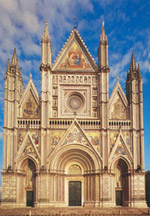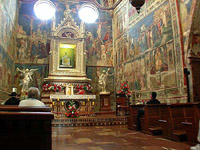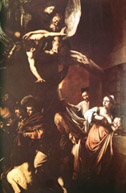|
|
Apartments in Florence, Perugia, Rome, Sorrento and Positano |




|
|
|
|
- You are in: Home » Umbria » Orvieto
VISIT ORVIETO
« All the regions
ORVIETO'S CATHEDRAL

The Duomo di Orvieto is a large fourteenth century Roman Catholic cathedral. The building was constructed under the orders of Pope Nicholas IV to commemorate and provide a suitable home for the Corporal of Bolsena, a miracle which is said to have occurred in 1264 in the nearby town of Bolsena. The cloth is now stored in the Chapel of the Corporal inside the cathedral. The flagstone of the cathedral was laid in 1290 by Pope Nicholas IV, and construction was entrusted to Fra Bevignate di Perugia using a design by Arnolfo di Cambio. Construction continued slowly until in 1309 the Sienese architect Lorenzo Maitani was commissioned to work on the church and solve several issues concerning the load-bearing capabilities of the building. He substantially changed the design and construction of the building, creating the current façade and much of the interior before his death in 1330 shortly before the completion of the duomo. The most exciting and eye-catching part of the cathedral’s exterior is its golden frontage, which is decorated by large bas-reliefs and statues of the Evangelists created by Maitani. Central to the mosaics is the large rose window built by the artist Orcagna between 1354 and 1380. The cathedral’s interior has deliberately been left uncluttered and spacious, with alabaster windows keeping the interior cool during the fierce Italian summer. The roof was decorated in the 1320s by Pietro di Lello and Vanuzzo di Mastro Pierno. Near the left entrance is the baptisimal font, created in 1390 by Luca di Giovanni and expanded sixteen years later by Sano di Matteo. It is overlooked by a fresco of the Madonna with child painted by Gentile di Fabriano in 1425. Behind the altar are a series of damaged frescoes by local artists Preto Ilario and Pietro di Puccino.
top
ST. PATRICK'S WELL

Created by the will of Pope Clemens VII and the extraordinary architectural genius of Antonio da Sangallo il Giovane ( helped by Giovanni Battista da Cortona), the well was started in 1528 and completed in 1537. It is a 62 – metre-deep and 13-metre-wide cylindrical hole with two spiral stairs illuminated by 72 arched windows, which channel the light of the central part. The two overlapping stairs are the peculiarity of the construction: they provided a passage for hundreds of pack animals ( one going upwards, the other downwards, in order not to create any hindrances), loaded with leather bags full of water takes from the San Zeno springs.
top
CORPORAL'S CHAPEL

Built to house the stained corporal of the miracle of Bolsena, the chapel is decorated with frescoes depicting miracles concerning the bleeding host throughout church history. Painted between 1357 and 1363, by Uglino di Prete Ilaro, Domenico di Meo and Giovanni di Buccio Leonardelli and are noted in part for their anti-semitism which was experiencing an upsurge in Western Europe at the period. There is also a painting by Lippo Memmi of the "Madonna de Raccomandati". At the centre of the chapel is a large golden reliquary containing the bloodstained corporal, which was built by Ugolino di Vieri in 1339. It is from here that the corporal is transported for religious processions through the town on feast days.
top
SAN BRIZIO'S CHAPEL

Some of the best Italian artists of the XV century appeared into the Chapel of San Brizio's turbulent history. The first was Beato Angelico, whose work was too slow, though. Therefore, he was sided by some young artists, such as Benozzo Gozzoli. In 1500, an agreement was finally reached with Luca Signorelli. The chapel, built between 1406 and 1444, is set on the right wing of the Dome's transept where there were also the sacristy and a semi-cylindrical small chapel belonging to the Monaldeschi family. It rises near the chapel of the S.S. Corporale that was built in 130 to preserve the relic of the Bolsena' s miracle. Beato Angelico, with the collaboration of Benozzo Gozzoli and Pietro di Nicola Baroni, carried out two of the four gores of the vaults as well as the decorations on the lateral bars. Luca Signorelli finished this work in five years' time, from 1499 to 1504. The Chapel of San Brizio, or Cappella Nova, was built in a time of profound artistic and political changes. Luca Signorelli was one of Piero della Francesca's pupils and he became well-known for his ability and for the use of perspective and the attention towards anatomy which was typical of the Renaissance artist. Just in Orvieto, he carried out the work that made him famous, namely the cycle of frescoes dedicated to the themes of the "Apocalypse" and the "Last Judgement": the "Storie dell' Anticristo", the "Finimondo", the "Resurrezione della Carne", the "Dannati", the "Eletti", the "Paradiso" and the "Inferno". In 1579, a marble statue, the "PietĂ " by the Scalza, was put inside the chapel. It is not there anymore, while it was only in 1622 that the chapel took the name of San Brizio, namely when the ancient altarpiece with the effigy of the "Madonna della Tavola", or Madonna di San Brizio, realized between the XIII and the XIV centuries, was carried there. In the XVIII century, Bernardino Cametti created the altar of the Gloria, a late-Baroque work that substituted the tabernacle of the Assunta. In the same period, the grave of the Cardinal Nuzzi was put inside the chapel, but it was later removed and the Cappella della Maddalena was renovated. Since the first half of the XIX century, numerous restoration works have been carried out and they were finalized in the last years with the creation of a new system of diffused lighting coming from below.
top
|
|
|
|
|
|
| TOP DESTINATIONS
|
| Adria Coast, Aeolian Islands, Alessandria, Altopiano Delle Rocche, Amalfi Coast, Aosta, Assisi, Asti, Bari, Brescia, Capo Vaticano, Capri, Catanzaro, Chianti, Cilento, Cinque Terre, Coast Of Marche, Conero Coast, Dolomites, Egadi Islands, Elba, Florence, Garda Lake, Gargano, Ischia, Italian Riviera, Lake Como , Langhe Piedmont, Lecce, Lucca, Lunigiana, Macerata, Mantova, Maremma Tuscany, Monferrato, Montepulciano, Naples, Perugia, Pesaro Urbino, Pisa, Pistoia, Positano, Prato, Procida, Riviera Of Palms, Rome, Salento Coast, Salerno, San Gimignano, Sardinia, Sicily, Siena, Sorrento, Terni, Tiber Valley Of Tuscany, Treviso, Turin, Val Gandino, Veneto, Venice, Viterbo |
|
|








